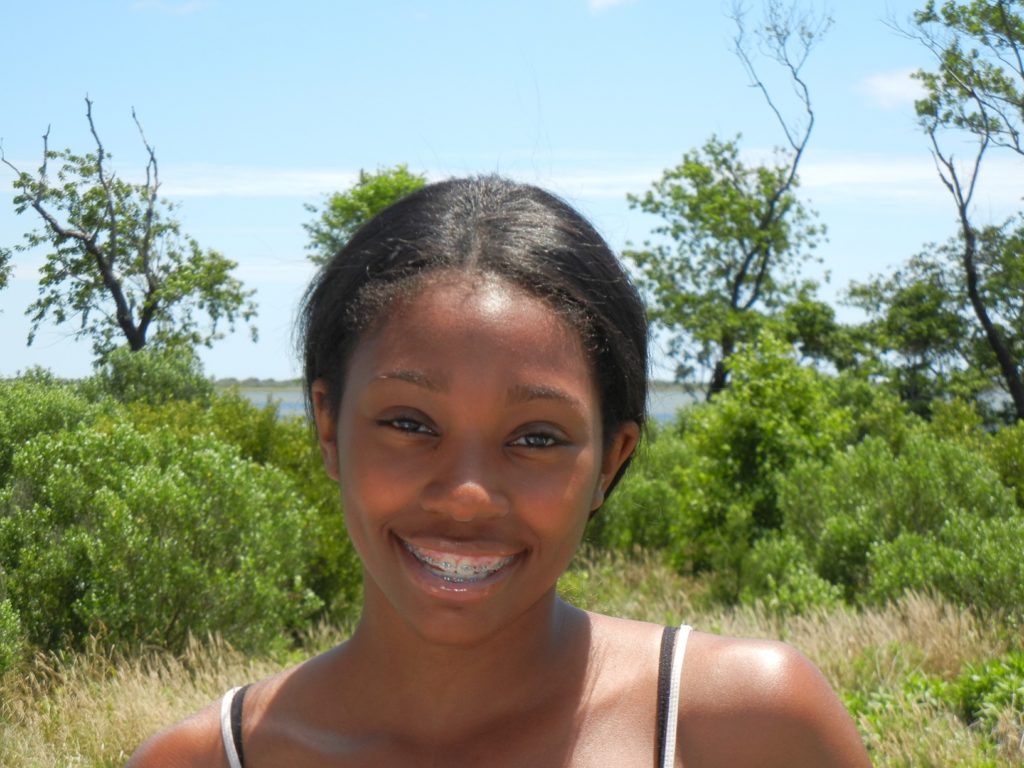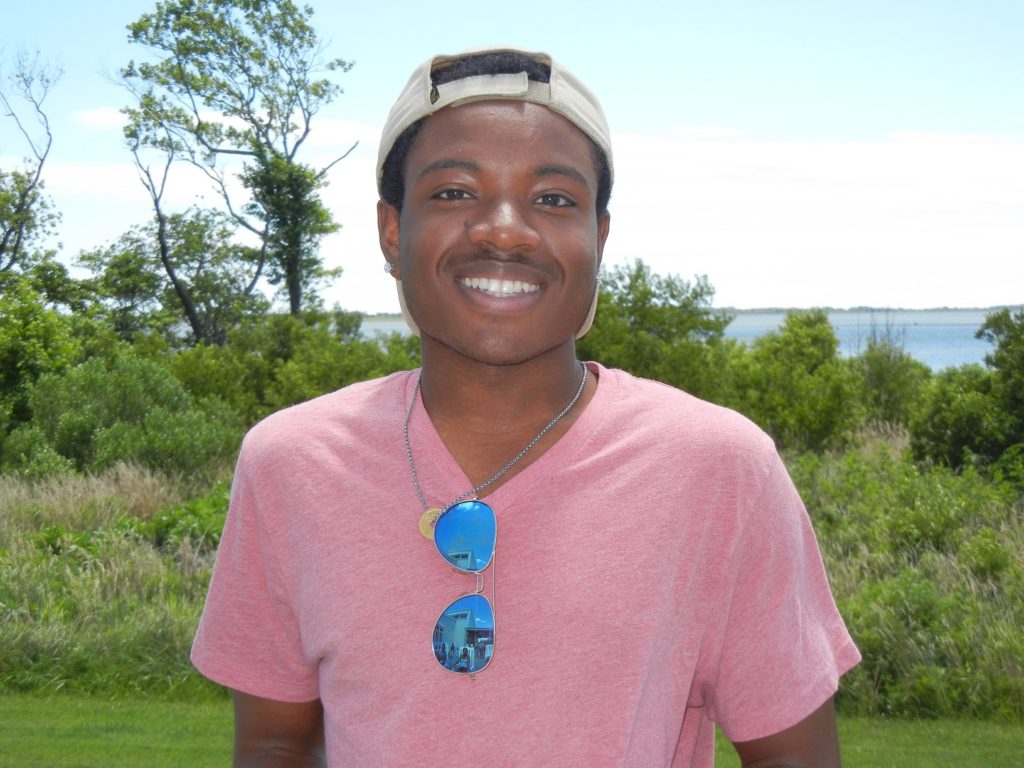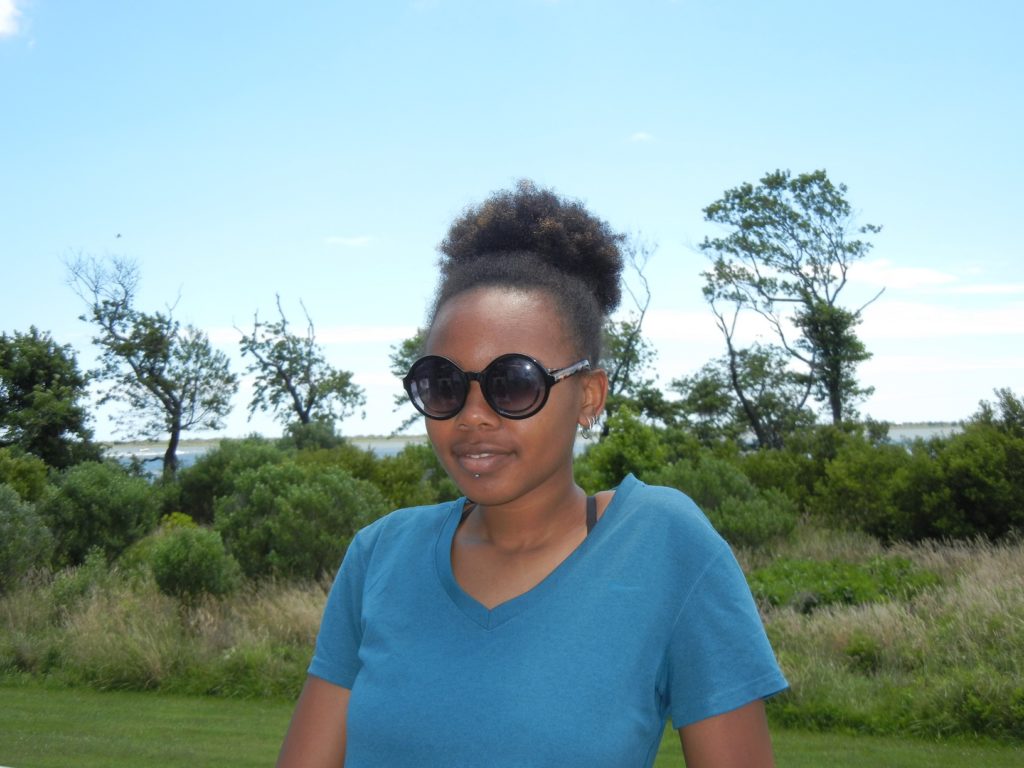2017 Student Participants

Eric Baril, University of North Carolina at Pembroke
Zooplankton distribution along a salinity gradient in the Maryland Coastal Bays
Faculty Mentor: Dr. Paulinus Chigbu
Zooplankton are patchily distributed both horizontally and vertically, especially in deep aquatic systems that thermally stratify in the summer. In very shallow lagoons such as the Maryland Coastal Bays (MCBs) with average depth of <2m, tidal currents and winds may cause sufficient mixing of the water reducing variations in zooplankton abundance with depth. To test this hypothesis, zooplankton samples were collected in June and July 2017 from four sites along a salinity gradient within the MCBs system from St. Martins River to Sinepuxent Bay. Six replicate samples (three from just below the surface and three close to the bottom) were collected at each site using a 30L Schindler-Patalas trap. The samples were immediately preserved in 5% buffered formalin. Temperature, salinity, dissolved oxygen and pH were measured with a YSI meter. Water samples were collected, stored in a cooler, filtered in the lab and used to determine nutrient concentrations. Mean total abundance of zooplankton dominated by copepod nauplii decreased as salinity increased from upstream (site 14) to downstream (site 7). Total zooplankton, total copepod, Acartia spp. abundances as well as abundances of most of the taxa did not differ between surface and bottom samples. Gastropod larvae were more abundant closer to the bottom of the water column than just below the surface at some sites, but the reverse was the case for copepod nauplii and harpacticoids. Polychaete larvae were most abundant at the site located in St. Martins River whereas Centropages were most abundant at site 15 closest to the Ocean City inlet where water temperature was lowest ( < 21oC). Collecting zooplankton, especially copepod, samples with a Schindler-Patalas trap just below the water surface seems suitable for estimating zooplankton taxa densities in the shallow lagoons of the MCBs since no significant differences were found between depths in the abundance of most taxa.

Nakia Coit, University of Maryland Eastern Shore
Perkinsus: an aquatic parasite as an alternative model for lipid metabolism
Graduate Student Mentor: Kristin Noell
Faculty Mentor: Dr. Joseph Pitula
Perkinsus marinus is a protozoan parasite that decreases oyster populations along the east coast. Perkinsus spp. are highly evolved in the utilization its host’s lipid resources for life cycle completion. One major concern is how do these protozoan parasites metabolize lipids and reproduce to infect other bivalves. In order to explore this phenomenon, two different lipid studies were conducted. Triclosan is an antimicrobial reagent that is used in many households, and commercial products. Triclosan has recently shown to bioaccumulate in the environment, thus leading to the possibility of becoming a contaminant of emerging concern. In addition to this, Triclosan is a known fatty acid synthase, inhibitor; therefore we were interested in testing the effects of this compound on Perkinsus growth to establish a correlation between lipid metabolism and growth. Perkinsus cells were grown in lipid media and non-lipid media with varying amounts of Triclosan. The optical density was recorded for a 24-hour period. Cells treated with Triclosan resulted in inhibited growth in both medias. Perkinsus cells were then observed under lipid and non-lipid conditions for a ten day period to examine their ability to proliferate, in which we saw a decrease in growth when no lipids where provided.

Katherine Draper, East Central University
Population ecology of blue crabs in the Maryland Coastal Bays
Faculty Mentor: Dr. Ejiroghene Mayor
Blue crabs (Callinectes sapidus), are abundant in the Maryland Coastal Bays MCBs). Its fishery contributes significantly to recreational and commercial landings on the East Coast providing income and jobs to the people. They are ecologically important as omnivores and scavengers of a host of benthic taxa, and are preyed upon by fish. Few studies have addressed the species’ seasonal and spatial abundance in the MCBs. Information is lacking on the population dynamics of the species across the Coastal Bays, and the influence of important environmental factors on the species abundance and distribution. Blue crab annual trawl survey data for the period 1990-2016 was obtained from the Maryland Department of Natural Resources. The abundance of C. sapidus significantly (P < 0.0001) varied annually, and was most abundant in late spring to early summer (June-July), but least abundant in October, H=4 7.73, P < 0.0001. Juveniles of C. sapidus were most abundant in spring while adults were most abundant in summer (P < 0.0001). There was no significant difference in size distribution of blue crabs across the Bays, although large crabs were found in the deep waters of Isle of Wight and Sinepuxent Bays. Matured female crabs were more abundant in the saltier IOW Bay (H=3 91. 5, P < 0.0001), in contrast to immature females and male crabs. All measured environmental factors had an inverse relationship with blue crab abundance (P< 0.0001) except for temperature that was positively related with blue crab abundance (RS =0 .039, p < 0.0001).

Edward Hughes, West Valley Community College and Mission Community College
An evaluation on the prevalence of heterotrophic bacteria, total coliforms, fecal coliforms, and Enterococci in Maryland’s Coastal Bays
Faculty Mentor: Dr. Ligia DaSilva
Within the Maryland’s coastal bays, fecal contamination is an important aspect to consider. If fecal contamination is present in the Maryland coastal bays, it could be bad for both humans and animals in the area. This experiment is meant to assess heterotrophic bacteria, coliforms, and Enterococci in water samples collected from Maryland’s coastal bays in order to better understand the effect of physicochemical parameters and nutrient levels on these bacteria. Quantification of bacteria was done using direct epi-fluorescent microscopy, MPN, and plate count methods. In addition, physicochemical parameters (temperature, salinity, pH, DO) and nutrient contents (total and reactive phosphate, nitrite, ammonia, and silica) of water samples were tested. With this knowledge, it can be better understood how to preserve the environment of the Maryland’s coastal bays. The highest bacteria count in June was 6.053 log(CFU/mL) at site 14 and the lowest was 5.875 log(CFU/mL) at site 11. The highest heterotrophic bacteria count for July was 6.133 log(CFU/mL) at site 2 and the lowest was 5.856 log(CFU/mL) at site 8. Site 6 showed very similar behavior over the course of two months, while site 2 experienced increases in all bacteria counts. Total phosphate mg/mL for site 11 also experienced a large increase which may have induced the increases in all bacteria counts at that site. Coliforms prefer lower salinity, while Enterococci has a higher salt tolerance and was able to grow more during the increase in salinity.

Alexis Humphrey, University of Texas at Austin
Analysis of wind velocity and tidal force on water quality in Isle of Wight Bay and Assawoman Bay, MD
Graduate Student Mentor: Katie Fitzenreiter
Faculty Mentor: Meng Xia
Wind velocity and tidal force influence water quality. This research analyzed data to build connections between these three parameters. Dissolved oxygen, turbidity, salinity, water temperature, and chlorophyll a are the five parameters that were analyzed in the Isle of Wight Bay and Assawoman Bay, MD. From 2008-2012 reports show unique patterns of data connecting the aspects of water quality to winds and tides. One additional focus was on the effects of Hurricane Sandy which hit MD in 2012. Data shows spike in salinity, and drops in water temperature around Hurricane Sandy’s strike.

Nylah McClain, University of Maryland Eastern Shore
Food web of the summer flounder using fatty acid analysis and gut content analysis
Graduate Student Mentor: Chelsea Richardson
Faculty Mentor: Ali Ishaque
Over the past 150 years the Maryland Coastal Bays (MCBs) have supported many recreational and commercial activities. As the population increased, activities in the bays increased. This led to changes and environmental impacts of the watershed. To better understand these environmental impacts on the MCBs a dynamic food web is needed for this complex ecosystem, beginning with the summer flounder, a fish that occupies all areas of the MCBs. By using fatty acid analysis and gut content analysis the diet of the summer flounder can be traced and identified. By comparing the types and abundance of organisms in the gut of summer flounder the food web could be established. Our hypotheses were that the diet of the summer flounder will differ between the Northern and Southern bays and that the diet of summer flounder will vary among seasons. Fatty acid were extracted as Fatty Acids Methyl Esters (FAME) using lyophilized summer flounder tissue by one–step fatty acids extraction and analyzed with GC-MS. Gut content analysis was done by dissecting and extracting the stomach contents. The stomach contents were placed in 70% ethanol and organisms were identified under microscope. The preliminary data shows a slight difference between the diet of Northern and Southern MCBs samples. The Northern samples feed more on zooplankton and diatoms compared to the Southern samples. The diet composition between 2016 and 2017 also differs. The 2017 samples were rich in species compared to 2016. However, to obtain more concrete data stable isotope analysis needs to be performed.

Annette Y. Micheli, University of Puerto Rico
Determining advective flow within the dead end canals of the Maryland Coastal Bays
Faculty Mentors: Dr. Eric B. May and Dr. Margaret A. Sexton
Manmade, dead end canals are common in residential developments along the coastal bays of Delaware and Maryland. These canals are stagnant bodies of water that have limited water flow. This study focuses on determining inflow and outflow rates from dead end canals, and to evaluate the impact on water quality. The study area was a straight canal just below 94th street in Ocean City, Maryland (Figure 1). Our hypotheses were that there was an exchange of water between the canals and bays due to the tidal exchanges, there were differences in water quality parameters, particularly dissolved oxygen concentration and percent saturation and that differences between early and late summer water quality parameters will exist. This work was done using a Secchi disk to measure water depth and visibility and a YSI meter to measure environmental parameters. Flow rates were measured using a Oceanic Flow Meter and were determined to be 0. For June 28th 2017, the dissolved oxygen concentration did not have a significant change. Over certain periods of time, dissolved oxygen concentration increased due to algae on August 1st 2017. For example, transect 4 spiked, whereas on June 28th it was lower. Dissolved oxygen saturation increased as expected due to a temperature increase. Water visibility was similar on June 28th while on August 1st, transect 4 was less visible due to high algal concentration. Salinity, pH and depth did not show a significant difference between both sampling days. This information allowed us determine there were no significant exchanges.

Isaiah Milton, Hampton University
Frequency of Vibrio parahaemolitycus and Vibrio vulnificus in blue crabs and seawater of the Maryland Coastal Bays
Faculty Mentor: Dr. Salina Parveen
The Vibrio genus, specifically Vibrio parahaemolyticus (Vp) and Vibrio vulnificus (Vv), are endemic to the marine and estuarine environments such as the Maryland Coastal Bays (MCBs). These Vibrio species are two of the most common of a dozen species that cause a human illness known as Vibriosis. The objective of this study was to analyze the prevalence of the Vibrio spp. in the Maryland Coastal Bays and determine the virulence of the species found in the Blue Crabs that reside there. Live crab samples (sizes ranging from 7 to 14 cm) were collected from six different sites along the Maryland Coastal Bays, along with seawater samples from the same sites. Crabmeat from the live crab samples was blended and serially diluted from 10 -1to 10-7. Hemolymph was also bled aseptically from the crabs and serially diluted from 10-1 to 10-4. The most-probable-number (MPN) methodology was utilized to determine the presence of bacteria in the samples, and qPCR was utilized to detect the presence of Vibrio spp. in the samples. Log MPN values of Vp ranged from 0.12 to 3.85 log MPN/g in crabmeat samples and was positive for 13.46% (tdh+) and 1.92%(trh+). Log MPN values of Vv ranged from -1.52 to -0.21 log MPN/mL in crabmeat samples and was positive for 33.33% (vcgC). The high concentrations of Vp and Vv within the crabmeat of the Blue Crabs from the MCBs indicates that the Blue Crabs have a high potential of being a source of Vibrio infection and are a public health concern.

Darrick Moore, Jr., University of Maryland Eastern Shore
Heavy Metal Analysis of Ocean Water in the Maryland Coastal Bays
Faculty Mentor: Dr. Nianhong Chen
The heavy metal concentrations of coastal regions will be measured, which will include Cd, Cr, Pb, Cu, and Zn. The sample will be taken from many different sites along the bay using various instruments to measure them. The use of the classic atomic absorption spectrometer is recommended coupled with various techniques including but not limited to graphite furnace technique, cold vapor technique, and the flame technique. As of now the use of the mass spectrometer with inductively coupled plasma (ICP-MS) is being used as the test instrument. The importance of measuring the heavy metal concentration of the environment is due to the issue that many aquatic animals intake much of these harmful metals that many people or other animals depend on for their daily food consumption. The main purpose of this study is to investigate the current status of the heavy metal concentration of the Maryland coastal bay area. The idea is to get samples from at least three different sites, range from many different areas of the bay. If there is a rising heavy metal concentration in the coastal bay area there is a potential ecological risk. Heavy metals intruded in the coastal areas through naturally occurring substances (biogenic) and several human activities (anthropogenic) such as domestic wastes, agricultural activities and industrial practices. In these areas there are potential releases of effluents, sewage, wastes and pollutants directly to coastal and bay areas or from rivers and streams which increase the existing concentration of particulate heavy metals.

Chryston Otubu, Hampton University
Concentrations of heavy metals in seawater, sediments, and crabs in the Maryland Coastal Bay areas
Graduate Student Mentors: Chelsea Richardson and Abdalhafiz Ahemedaltayb
Faculty Mentor: Dr. Ali Ishaque
Heavy metal pollution can be incredibly detrimental to the biological health of an ecosystem. The ability for heavy metals to bioaccumulate through the food web is what makes them environmentally disastrous. To combat this public health issue in the Maryland Coastal Bays (MCB’s), we must see if bioaccumulation is present in the MCB ecosystem, as well as how high the heavy metal concentrations are. It is believed that the concentrations of heavy metals will be significantly higher in the warmer months, in the more developed sites than during the colder months in the more untouched areas. Following the idea of bioaccumulation, the heavy metal concentration will be the highest in the crab hepatopancreas when compared to the sediments and water. First, monthly samples of sediments, water, and blue crabs, Callinectes sapidus, were collected from sites in the coastal bays as well as dead-end canals. Sediment samples and crab samples were freeze-dried, then digested using a microwave assisted sample treatment. Water samples were filtered. After being diluted, all samples were analyzed using inductively coupled plasma mass spectrometry (ICP-MS) to detect the heavy metal concentrations in them. Looking at the concentrations, it was clear that the crab samples had the highest concentration levels of elements overall when compared to sediment and water samples. On average, the dead-end canal sites were more contaminated than the Maryland Coastal Bay sites. Further studies on heavy metal concentrations in the Maryland Coastal Bays are needed to see if these trends are real levels.

Nia Riggins Bryn Mawr College
A study of glycoconjugates on Perkinsus marinus
Graduate Student Mentors: Bernadette Ezeabikwa and Jorge Rodriguez
Faculty Mentors: Dr. A. Kwame Nyame
The purpose of this study is to determine if Perkinsus marinus contains glycoconjugates on its cell membrane. The hypothesis for this question is that P. marinus has carbohydrates surrounding their cells which are used to interact with the sugars on the cell of the oyster. Glycoconjugates are believed to allow the protozoan to infect its host. We investigated the presence of glycoconjugates on the cell surface by staining them with plant lectins. These lectins are known to bind specific cell surface glycan structures. Through this initial experiment P. marinus was discovered to bind strongly with Sambucus nigra lectin (SNL) which binds to cell surface α- 2,6 linked sialic acid residues. This suggest that SNL synthesizes complex glycoconjugates which mediate the interaction between the parasite and its host.

Melati Tarrant, University of Rhode Island
Testing fecundity estimation methods for Jonah crabs (Cancer borealis) using digital image analysis
Graduate Student Mentor: Noelle Olson
Faculty Mentor: Dr. Brad Stevens
Jonah crab, Cancer borealis, have been caught as bycatch in lobster traps since the mid-1960s. Jonah crab is one of eight species of cancer crabs and are found mainly along the eastern coast of the United States. Fishermen may either keep the whole crab or take the claws and throw the crab back. Because Jonah crabs have become more popular, the Atlantic States Marine Fisheries Commission began an interstate fishery management plan in June 2016. The ASMFC plans to support and promote the development and implementation of a unified coastal management program for Jonah crabs. Jonah crab is a data poor species and there is not a lot of available information on their reproductive biology. We have collected different sizes of ovigerous female Jonah crabs and estimated female reproductive output. Fecundity estimates can help predict Jonah crab reproductive output which can help guide management. The crab we used in the analysis was 104.08 mm carapace width with an estimated range of 462,912 to 553,488 eggs. We hypothesized that coefficient of variation (CV) would decrease in sample size and found that this is true. This means that the more pictures that are photographed of the eggs the lower the variation will be between each photo.

Tidas Thompson, Tuskegee University
Redesigning Aquaculture Biofilters and Aquaponic systems to Improve Fish Life
Faculty Mentor: Dr. Eric May
The bio filter is the most important constituent when trying to maintain healthy water quality for fish. Bio filters are the building blocks for aquaculture today. Bio filters are simply a place for fish bacteria to colonize. It provides large surface area, proper temperature, pH and regulates ammonia, nitrite, and nitrate. Here, at UMES we constructed two bio filters achieving to reduce ammonia in aquaponic systems so that we may ultimately discover a more effective path to maintaining healthy water quality for fish. Once construction of our systems were fundamentally established, we began to test the efficacy of our designs. To exploit concrete concentrations samples we utilized a colorimetric testing kit which provided accurate results to base our observations on. Overtime, we observed the efficiency in reducing ammonia concentration in our designs and made note of such differences. All in all, system 1 ended up proving itself much superior than the latter. With further technological advances, the biofilter will improve its job in aquaponics and with better efficiency means extended fish life subsequently, providing the area with fresh leafy greens.


